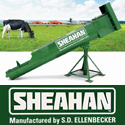 |
 |

|
|
|
Wisconsin Ag News Headlines |
 |
Conley: Soy Producers Must Weight Factors to Boost Yields
Wisconsin Ag Connection - 04/24/2014
There's no question that making timely decisions during the crop season can be the key to maximizing yields in your soybean crop. In fact, Wisconsin State Soybean and Wheat Extension Specialist Shawn Conley says those decisions are also vital in making a profit.
"Farmers have many considerations that effect soybean yield including variety selection, planting date deciding to apply inputs such as potassium, calibrating their planters for maximum yield and managing for seedling and plant diseases, yield-robbing pests and seedling," Conley said.
He recommends that soybean farmers compare variety performance results from multiple sources including university and private results, locations and environments.
"One common mistake can be only looking at local data from your own farm, a neighbor's farm or from county data," he says. "Local data, while interesting, only provide a glimpse at how well that soybean variety performed last year in a narrow area. Comparing variety performance over many different
environments and factors will offer farmers the best predictive ability for next year's environment."
Planting multiple soybean varieties to diversify plant genetics may be a good strategy in lowering risks of yield loss due to stress factors. Conley recommends paying attention to maturity groups because later-maturity group soybeans often lead to increased yield; however, timeliness of harvest and frost must be
considered. Once a group of high-yielding soybean varieties has been selected, the next decision is choosing varieties that meet specific disease, insect and weed resistance/tolerance characteristics keeping specific fields in mind.
Research conducted at the Arlington Agricultural Research Station has shown an average yield loss of 0.4 bushels per acre per day when soybean planting has been delayed past the first week in May. Yield loss in delayed plantings can be attributed to decreased seed number per acre.
Delayed plantings of soybeans can partially compensate for reduced pod number per acre through increased seed size. Early soybean planting dates can lead to increased risk of seedling diseases, white mold, brown stem rot and sudden death syndrome.
Meanwhile, row spacing can be a factor in yields as well. The yield response of soybeans in wide rows versus narrow can vary by zero to 18 percent. The amount of water and light drives yield. On average, research shows a seven percent yield difference between wide (30 or more inches) and narrow (15 inches
and less) rows.
Other Wisconsin Headlines
|
|
 |


|
 |
|
Copyright © 2024 - Farms.com. All Rights Reserved. |
 |
|